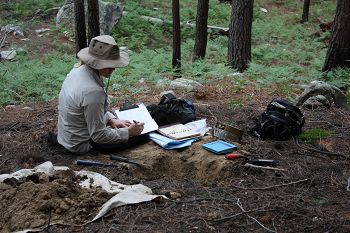Sample Collection Resources
Multiple methods of sample collection are employed by CZO scientists in order to obtain solid, liquid and gas samples that are subjected to detailed interrogations in the laboratory.
Photo was taken at the Mid-OR CZO granite site in the Catalinas. Rebecca Lybrant is sapling a soil pedon in the Mid-Ponderosa Pine vegetation zone as part of the environmental gradient work I am doing to evaluate the effects of climate and landscape position on soil weathering and soil organic carbon storage.
CZO samples are collected for analysis: (i) during CZO instrument installations, (ii) by in-situ sample collection equipment that is “semi-permanently” installed at various locations within the CZ, and(iii) during specific separate field campaigns.
For an example of (i): whenever soil pits are excavated for the purposes of subsurface sampler or sensor installation, composited soil samples are collected as a function of depth for a suite of subsequent laboratory analyses that provide information on mineralogy, geochemistry, organic matter composition, microbial composition, etc.
For an example of (ii): Samplers are installed in specific landscape locations throughout the SCM and JRB, particularly in the instrumented ZOBs, that are visited for regular (e.g., event-based or weekly) collection of vadose zone, saturated zone, and surface water samples.
For an example of (iii): Annual snow surveys are conducted near maximum snowpack to collect data on snow water equivalent and its distribution as a function of position with regard to aspect, vegetation structure, etc.
Collecting stream water sample.
Explore Further


